Brazilian house prices continue to rise, albeit at a slower pace
Brazil remains one of the world’s strongest housing markets, though house price increases are decelerating sharply. Brazil’s composite FIPEZAP house price index rose by 11.9% (5.1% inflation-adjusted) during the year to end-May 2013, lower than the year-on-year increase of 19.9% seen over the same period last year.
During the year to May 2013:
- In Sao Paulo, house prices rose by 14.1% (7.1% inflation-adjusted), down from a 21.5% year-on-year rise from the same period last year.
- In Rio de Janeiro, house prices increased by 14.5% (7.5% inflation-adjusted), lower than the 24.1% annual increase recorded in the previous year.
From January 2008 to December 2012, average house prices in São Paulo and Rio de Janeiro rose by 159% (98% inflation-adjusted), and by 194% (124% inflation-adjusted), respectively. The mortgage market also grew from just 1.5% of GDP in 2007 to about 6.2% of GDP in 2012.
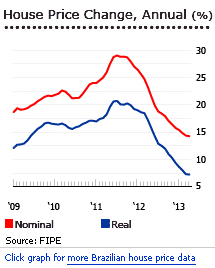
Brazil’s housing market boom is mainly due to the continuous decline in interest rates in recent years. From a recent high of 26% in 2003, the Banco Central do Brasil’s Selic rate has fallen to 7.25% in 2012. Following the movements of the Selic rate, mortgage interest rates also fell, which stood at about 10% to 12% in early-2013. However, the central bank has changed its monetary course of action in the first half of 2013, raising the benchmark interest rate in its two consecutive meetings to 8% in May 2013, to rein in inflationary pressures.
The weakening economy and the central bank’s contractionary monetary policy are expected to have negative impacts on the housing market during the remainder of the year. However, many foreign investors remain optimistic about the Brazilian housing market, as Rio de Janeiro will host the FIFA World Cup final match in 2014, and the Olympics in 2016, which may augur well for house prices in that city.
In addition, President Dilma Rousseff has been recently pouring money into the housing market, using federal subsidies and state bank loans. Rouseff has nearly doubled spending on the country’s plan to build two million affordable homes by 2014.
The economy grew by an annualized 2.2% in Q1 2013, from 2.6% in the previous quarter. The Brazilian economy is expected to grow by 3.1% in 2013, up from real GDP growth rates of 0.9% in 2012 and 2.7% in 2011, based on projections by the Banco Central do Brasil.
Capital Economics’ case for a bubble
For over the year now, a US-like credit bubble has been feared to exist in Brazil. The country’s economic growth is slowing, and the wider global environment is not encouraging, with Europe’s sovereign debt crisis worsening, and Asia slowing.
Capital Economics argues that the situation is now critical:
- Although credit as a share of GDP is low by developed world standards, Brazil has experienced a large jump in credit growth, which doubled from 25.8% in January 2005, to 50.6% in June 2012;
- Brazil’s debt service burden eats up 23% of disposable income, up from around 10% of income in 2005, according to a recent IMF report. The US’s debt service ratio stood at 18% when the credit bubble burst in 2007, up from 12% in 2000.
- Default rates have started, to rise reaching 7.8% in June 2012
- Capital Economics estimates that housing could be overvalued by around 30% to 50%.
Brazil’s consumer credit explosion resulted from a 10-year economic boom and increased domestic consumption, especially among the poorer classes. Mortgage credit, in particular, has been pushed by banks to homebuyers, especially to low and mid-income first-time homebuyers who are very sensitive to interest rate movements. Despite being at a historic low of 8%, Brazil’s key interest rate remains high, and a rise in rates could make first-time buyers struggle to finance their mortgages.
The International Monetary Fund (IMF) however points to risk-mitigating factors:
- Relative to international standards, Brazil’s credit-to-GDP ratio remains low. The benefits of macroeconomic stabilization and gains in financial inclusion make up a significant portion in the recent credit expansion;
- Credit expansion has slowed in recent months, especially household credit. The estimated credit-to-GDP ratio has fallen significantly from its 2009-peak;
- Banks are seemingly resilient to adverse shocks;
- Bank supervision is strong. If the bubble bursts, the impact of any price decline on the wider economy may be somewhat moderated by the low share of housing loans in banks’ loan portfolios, the (IMF) notes.
The rise of the middle class
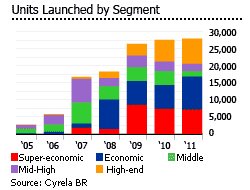
Brazil’s president Dilma Rousseff has been pushing Brazil further on the road to development charted by Lula da Silva’s, lifting many Brazillians from poverty unto the middle class. The successful poverty reduction program has led to real average incomes rising by 9% from 2002 to 2012, according to the Instituto Brasileiro de Geografia e Estatistica (IBGE).
“What I want my legacy to be is this country to be increasing middle class, to be highly competitive and highly educated,” Rousseff told Forbes.
In 2011, 54% of Brazilians were middle class, up from 34% in 2004, according to Cetelem BGN and Ipsos Research Institute –a total of 103 million middle class Brazilians, who account for 46% of the country’s purchasing power. Rousseff predicts that around 60% of Brazilians will be middle class by 2018.
The expansion of Brazilian middle class has made it real estate’s target market, replacing wealthy international buyers who used to dominate the market in major cities like São Paulo and Rio de Janeiro.
Developers like Cyrela (a develop with a 10% market share in São Paulo and 25% share in Rio de Janeiro) have shifted from luxury projects, to the “economic” and “middle” segments, i.e., to middle-class buyers.
Out of the 27,690 units launched by Cyrela in 2011, 7,155 units (26%) were for the super-economic segment, 9,690 units (35%) for the economic segment, and 1,500 units (5%) for the middle segment.
In contrast 2,227 units (8%) were for the mid-high segment and 7,388 units (26%) for the high-end segment. In 2006, mid-high (48%) and luxury (5%) segments made up more than half of Cyrela’s launches.
Housing credit is expanding; mortgage market remains small
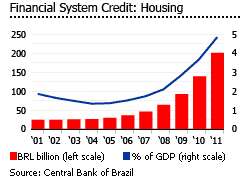
Lula’s pro-market reforms have greatly helped expand Brazil’s mortgage market. The first big break was the government’s approval of fiduciary alienation, whereby the buyer becomes the owner of the property only after it has been fully paid. The bank or lending institution holds ownership of property, while the loan is being repaid.
This gives banks security, if buyers default. In the past, banks were reluctant to lend to households, because Brazilian courts were biased in favour of borrowers.
Brazil’s new Housing Finance System (SFH), offers households an opportunity to turn their higher incomes into mortgage payments. SFH had experienced over the past few years, an increase in housing finance volumes, which wasn’t attained during regarded SFH’s best years in early 1980’s.
According to a Warnock & Warnock (2008) study, out of a stock of 54 million housing units, around 9.5 million of them were financed under the SFH, while most were produced by homeowners themselves. Although a small number, the amount of financed units were already high considering the country’s small mortgage market.
The SFH’s resources are administered by Caixa Economica Federal (CEF). Medium and high-income families use the Cadernetas de Poupança (CP) or private savings accounts. The Fundo Garantia por Tempo de Servico (FGTS), which are employees’ monthly private accounts, is used for low-income housing.
In June 2012, the CEF announced the expansion of 30 to 35 years maximum terms of home financing. Interest rates were also reduced from 9% to 8.85% for properties funded by the SFH. Depending on the level of relationship with Caixa, the rate could reach 7.8%. Those out of SFH, the rates were reduced from 10% to 9.9%, or may even reach 8.9%.
Brazil’s mortgage market remains small at 3.8% of GDP in 2011, up from 1.4% in 2005. On the other hand, financial system credit for housing increased by five times from BRL 29 billion (US$ 14.1 billion) in 2005 to BRL 200 billion (US$ 97.7 billion) in 2011.
In June 2012, financial system credit for housing expanded by 40.6% to BRL 235 billion (US$ 114.8 billion) from the same period last year.
Benchmark rate is falling
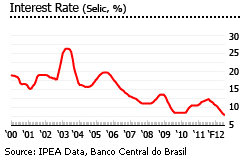
Brazil’s benchmark rate was once one of the world’s highest. But successful economic reforms over the past several years have pushed Selic, Brazil’s central bank benchmark rate, from nearly 30% in 1998 to 8.65% in August 2009.
The government raised the rate several times to curb inflation from March 2010 to August 2011, reaching 12.42%. Unexpectedly, the central bank cut its key interest rate in September 2011 due to slowing global and domestic economic growth and has continued to do so, reaching an all-time low of 8.07% in July 2012. The benchmark rate is likely to decline further to 7.25% by end of 2012.
Declining rental yields
Brazil’s continuously rising property prices has been pushing down rental yields.
In Rio de Janeiro, where strongest price movement were witnessed, rental yields for apartments ranged from 4.03% to 5.36% in November 2011, according to the Global Property Guide, down from average yields of 7.8% in 2009.
Rental yields in São Paulo ranged from 4.22% to 7.81%, with higher yields for smaller apartments, down from average yields of 8.33% in 2009.
Penthouses in São Paulo can have yields ranging from 6.7% to 8.75%.
Housing deficit
Brazil still has Latin America’s highest level of inequality, very visible in the favelas on the hilly outskirts of Rio de Janeiro and other cities. The underlying problem of housing scarcity remains, as is evident in the 8 million “housing deficit” in 2011, a climb from 6.4 million units in 2005. Of this, 90% belongs to the poorest income bracket.
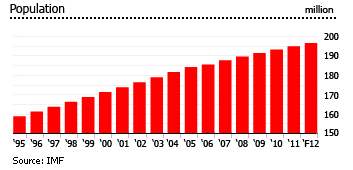
Brazilians, especially the poor, find housing unaffordable because of the high property prices. In São Paulo, around 62% of families find it expensive to own a house, based on a study by the Inter-American Development Bank (IADB).
Home ownership is at 75%, with only about 14% of the 42 million housing stock rented. But around 85% of all homeowners live in low quality, self-built, single-room housing units.
São Paulo’s metropolitan area has an estimated population of 19.8 million, based on the IBGE’s August 2011 estimate. Brazil’s 15 most populous metropolitan areas account for 37.35% of the total population.
Favelas were named after the squatter settlements on the hill Morro da Favela, near the centre of Rio. It is estimated that about one-third of Rio’s population lives in favelas. The situation is the same in other major cities, such as Brasilia and São Paulo; perhaps 40% of these cities´ population lives in these squatter settlements.
My Home, My Life
The housing program Minha Casa Minha Vida (My House, My Life), launched in March 2009, was one of the popular federal government programs launched during former President Lula da Silva’s 8-year term.
With an initially allocated budget of BRL 36 billion (US$ 17.55 billion), the program aimed to build 1 million houses during 2009 and 2010 for low income families, specifically those earning up to three times the national minimum salary. By end of 2010, 1,005,028 units had been contracted, according to CEF.
The second stage of the program was officially launched in June 2011. It has a government budget allocation of BRL 72 billion (US$ 35.10 billion), and targets the construction of an additional 2 million houses by end-2014. By August 2012, one million houses had been built. President Rousseff announced that by 2014, her administration would have contracted 2.4 million houses, added to the one million houses contracted under the previous administration.
Some changes were introduced in the latter stage such as the increase of price ceiling for units, end of height restrictions on apartment blocks and installation of solar panels.
Of the total three million houses:
- 1.6 million homes are intended for families earning 0 -3 times the monthly minimum wage (earning between BRL 0 and BRL 1,635 a month)
- 1 million homes for families with salaries 3-6 times the monthly minimum wage (monthly income ranging from BRL 1,635 to BRL 3,270)
- 400,000 homes are allocated for families earning 6-10 times the monthly minimum wage (monthly wages between BRL 3,270 and BRL 5,450).
Under the program, subsidized mortgage loans were extended to middle and lower income homebuyers through the state-owned bank, Caixa Economica Federal (CEF).
Northeast Brazil’s growing popularity
Northeast Brazil, the poorest region in Brazil, is now catching up with the prosperous Southern Brazil. Though the Northeast region remains the poorest, with 27.8% of the country’s total population but accounting for just 13.5% of GDP in 2011, the region has been the country’s star economic performer over the past decade.
From 2000 to 2010, Northeast’s real GDP growth rose by an annual average of 4.2%, higher than the 3.6% annual growth for the rest of the country.
The Northeast has become a popular holiday destination for wealthy Brazilians in recent years, thanks to its fine beaches.
Now the area – particularly the cities of Natal, Recife and Fortaleza – benefits largely from the residential property boom and improved tourism infrastructure. Smaller towns with higher housing deficits are part of the Minha Casa, Minha Vida programme. Demand for rental accommodations has risen particularly in more desirable areas.
Second-home buyers from the southern and central regions have also turned their attention to Northeast Brazil. Coastline properties in Northeast Brazil are still a lot cheaper than those near São Paulo or Rio de Janeiro.
“Right now, the northeast is one big building site,” says Federal Integration Minister Fernando Bezerra Coelho. The port and industrial complex of Suape is being expanded. A petrochemical plant and a huge car factory are under construction. The government is expanding the Atlantic coastal highway. Over a hundred firms have moved in. The 2014 World Cup stadium is being constructed in Natal.
Granted that there is a marketing hype over the northeast, there are still risks involved in investing there. According to Exame Magazine, there were visible declines observed on overseas investment in Natal over the recent years, due to lack of capital availability from Europe (which makes up most of foreign demand for the secondary market in the Northeast).
Long term industrial sustainability is also questionable, since most states in the Northeast rely heavily on tourism, fisheries and agriculture.
According to Ruban Selvanayagam, housing developer and investment advisor for the Fez Tá Pronto Construction System, the Northeast’s main problem, as well as Brazil’s, is inflation in the price of land, labour, and construction materials. Selvanayagam also points out that salaries in the region are mostly lower than average class D and E earnings of BRL 792 (US$ 386), the prime market of the Minha Casa, Minha Vida program.
Modest economic growth in 2013
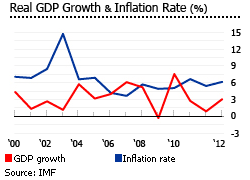
Brazil’s economy grew by an average of 4.3% from 2004 to 2006 and then by an average of more than 5% during 2007 and 2008. Brazil wasn’t spared in 2009, but the economic contraction was minimized at 0.3%. Real GDP growth rates were 7.5% in 2010 and 2.7% in 2011, despite the adverse impact of the eurozone debt crisis.
Inflation is one of Brazil’s main problem. In April 2013, annual inflation stood at 6.49%, already at the upper limit of the central bank’s target band of between 2.5% and 6.5%, according to the BCB. In 2012, the country’s overall inflation rate was 5.84%, from 6.5% in 2011, 5.91% in 2010 and 4.31% in 2009. Real wages dropped by 0.2% month-on-month in April 2013, to an average of US$908 per month. Still, real wages were 1.6% higher than the previous year.
In 2012 the economy grew by a meagre 0.9%. Brazil’s unemployment rate rose unexpectedly for the fourth consecutive month to 5.8% in April 2013, according to the Instituto Brasileiro de Geografia e Estatistica (IBGE). Despite this, unemployment remains relatively low. It was still lower than the 6% jobless rate seen in the previous year and the lowest jobless rate for the month of April since IBGE started collecting data in 2002.
The Brazilian economy is expected to grow by 3.1% this year, based on projections by the Banco Central do Brasil (BCB), the country’s central bank.
In an effort to boost the economy, President Dilma Rousseff introduced a tax relief programme, subsidies and protection for industry, increased social welfare benefits for low-income earners and unveiled enormous infrastructure programmes. To control inflationary pressures, the central bank raised the Selic rate by 50 basis points to 8% in May 2013, following a 25 basis points increase earlier this year.
Standard & Poor’s has recently downgraded its outlook for Brazil’s sovereign rating from “stable” to “negative”, amidst slowing economic growth, deteriorating budget fundamentals, high inflation and a decline in the credibility of the government’s economic policies given ambiguous policy signals.
The legacy of the riots
In June 2013 riots exploded, precipitated by a R$0.20 (US$0.10) raise in public transport fares, and complaints about excessive spending on mega-sporting events. But the real causes go deeper. Brazil’s infrastructure is in terrible shape – education is poor, public transport is terrible, state provision of ports, airports, and health is of very poor quality. Many Brazilians spend up to four hours per day in traffic jams, either in their cars or on crowded public transport.
Brazil is not a poor country and the tax rates are extremely high. So the protests are better seen as an outburst of popular frustration at corruption – a protest against an intolerable situation familiar to many citizens in many other developing countries
“Brazilians see no reason to have such bad infrastructure when there is so much wealth that is so highly taxed,” noted a CNN report. “Aside from the problem of infrastructure, several corruption scandals which remain without trial, with the cases tending to end with the acquittal of the defendants.
“The biggest corruption scandal in Brazilian history finally ended with the conviction of the defendants and now the government is trying to reverse the trial by using maneuvers through unbelievable constitutional amendments: one, the PEC 37, which will annihilate the investigative powers of the prosecutors of the public ministry (the Brazilian equivalent of the District Attorneys), delegating the responsibility of investigation entirely to the Federal Police. Moreover, another proposal seeks to subject decisions of the Brazilian Supreme Court to the Congress - a complete violation of the three powers.”